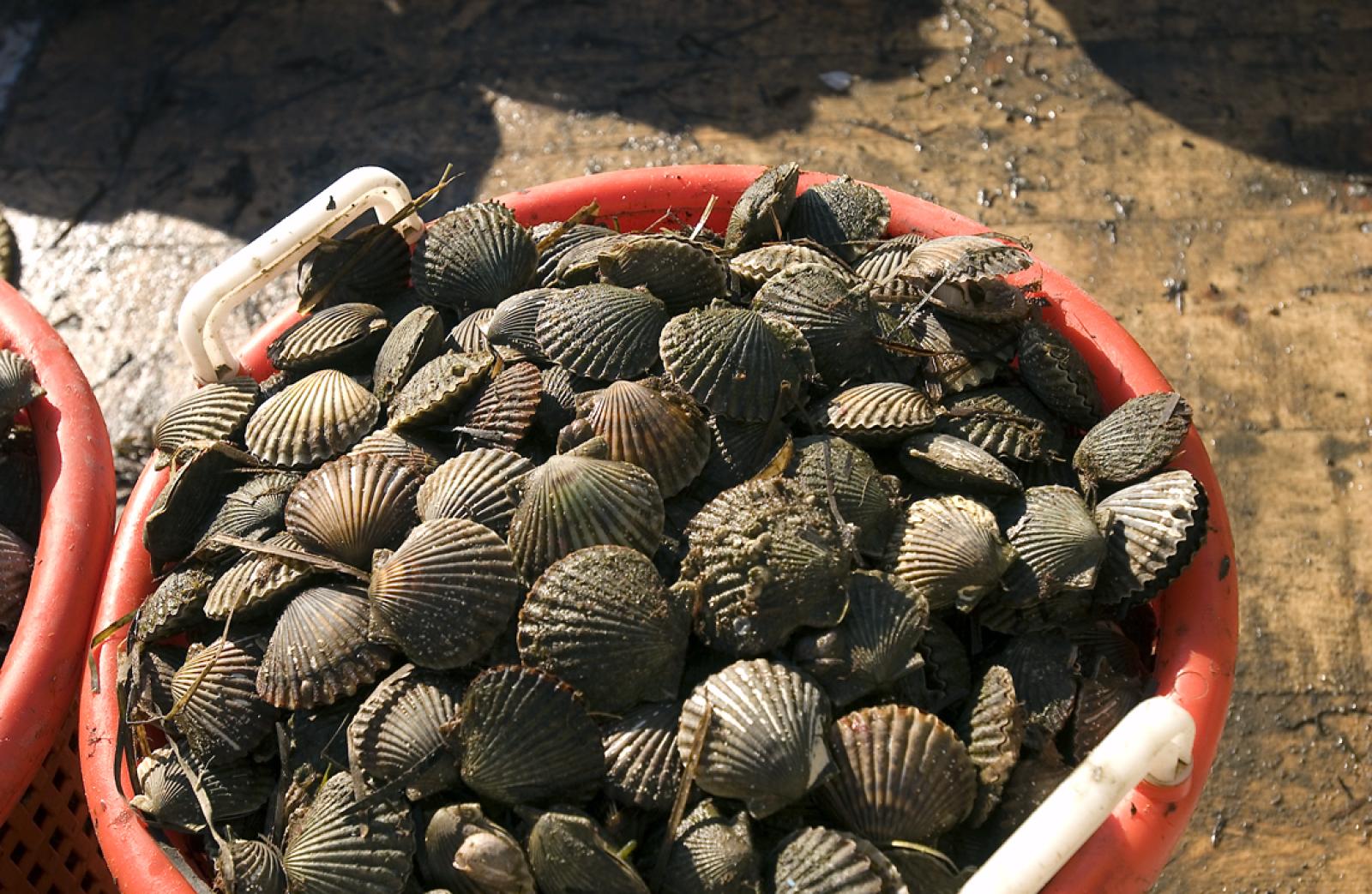Vineyard bay scallops, the Island’s biggest export this time of year, are at a premium.
Even though fishermen are coming ashore on the mainland with product, Roy Scheffer of Edgartown, a longtime commercial fisherman, said: “We have the nicest scallops. It looks like it is going to be a good Christmas.”
The price fell early in November, but it is back up now. At the market, fishermen can expect to get paid as much as $13 a pound for their shucked product. Consumers can expect to pay close to $17 a pound retail.
Shellfishermen are landing them in Edgartown, Chilmark and Tisbury. With the winter clime settling in, only the heartiest and more experienced fishermen are out after sunrise. Yesterday’s high winds and rain early in the morning kept the fleet at home. But on a good day, Mr. Scheffer said he sees about 45 fishermen out on 24 boats in Cape Pogue Pond.
“I wish it was like this every year,” he said. It looks like there will be enough for the fishermen to keep dragging until spring.
“The price started out at $10 a pound,” Mr. Scheffer said. “Then it went down to $8 and then $7 for a little while. And now it is back up.”
The reason for the variation has more to do with the market on the mainland than here. Vineyard seafood handlers ship plenty of bay scallops to the mainland from Edgartown, Tisbury, Oak Bluffs and Chilmark.
The commercial season opened in most areas in the first week of November with a lot more sources than just Martha’s Vineyard and Nantucket. Chatham, which hasn’t had the valued bivalve for more than decade, all of a sudden had more than they were accustomed to finding. Even Long Island had scallops, though that season was the shortest of all.
Louis S. Larsen, owner of the Net Result, said those bay scallops, together with Nantucket and the Vineyard scallops, flooded the market.
“Suddenly Chatham had them. There was no one there who knew how to cut them. So they got dumped on the market, and the market got flooded,” Mr. Larsen said.
While Nantucket is having a good season and it will likely continue, Mr. Larsen said he is hearing a lot of compliments of the Vineyard bay scallops when comparing the two Islands.
“Nantucket has plenty of bay scallops but they are all small,” Mr. Larsen said. Usually Nantucket has large meats and that makes them preferable. “They used to cut eight or nine pounds to the bushel. Normally they are bigger than ours. But this year they are getting five or six pounds to the bushel,” Mr. Larsen said. “That makes us a primary source.”
Mr. Larsen said he knows that Chatham and Long Island have run out of bay scallops because they are his latest customers.
Isaiah Scheffer is the Chilmark shellfish constable. He is Roy Scheffer’s son. Last year, Chilmark shellfishermen landed 1,700 bushels of bay scallops for the season. They won’t come close this year, and the fishermen have to work hard to get the two bushel limit.
“They’ll leave the dock at 7 a.m. and be back at noon with a bushel and a half, two bushels by 2 p.m.,” Mr. Scheffer said. The scallops aren’t big like Edgartown’s”; Mr. Scheffer said Chilmark fishermen are getting seven pounds to a bushel. “They could get eight pounds to the bushel if they are out on the flats,” Mr. Scheffer said.
Mr. Scheffer said a half dozen bay scallopers are still going; all of them are the town’s seasoned shellfishermen.
While the economy may be going south, for these shellfishermen, bay scallops are their livelihood.
Roy Scheffer said nearly all of the bay scallopers fishing in his town are “die-hard” fishermen. That is what they do. “I do it because I don’t know any better,” he said.
Edgartown shellfish constable Paul Bagnall said his town sold 70 commercial shellfish licenses this year, twice as many as last year. A couple of those commercial licenses were taken up by what Mr. Bagnall calls “younger kids.” Mr. Bagnall estimated that around 600 bushels of bay scallops are landed a week, significantly more than last year.
In past economic downturns on the Island, many of the shellfishermen were folks who had lost work in construction.
“Years ago, carpenters used to go bay scalloping for the first couple of weeks, as long as they made more money,” Mr. Larsen said. “Now they don’t have a boat in the yard, so they don’t go.”
Mr. Larsen said an unemployed carpenter wouldn’t think of going bay scalloping if he couldn’t find work these days. The cost of the boat, the outboard and the gear can run upwards of $10,000. “You can’t count on income every year,” Mr. Larsen said.
This year income is coming from across the country, because the Vineyard bay scallop has plenty of distant followers. Mr. Larsen said he is shipping to Denver, Seattle and Los Angeles markets. Consumers can make the distinction between bay scallops that come from Martha’s Vineyard and those that come from foreign ports.
The Chinese farm-raised bay scallop may be flooding the market at $4.99 a pound, but Mr. Larsen said he is not concerned. “The consumer knows,” he said. Every once in a while he gets a customer who will complain they can get foreign raised bay scallops cheaper. “They come from Mexico, Argentina, Brazil and Peru,” Mr. Larsen said. “It just doesn’t taste the same,” he said.
Mr. Bagnall said Island shellfishermen can welcome the return of the bay scallop fishery to places like Chatham. “It expands the market.” The more people get an opportunity to taste the New England bay scallop, the more consumers will ask for it in the future.
Then, as has happened now, when the bay scallop fishery runs dry on the mainland, the buyers turn to the Vineyard to refill their empty trays.






Comments
Comment policy »